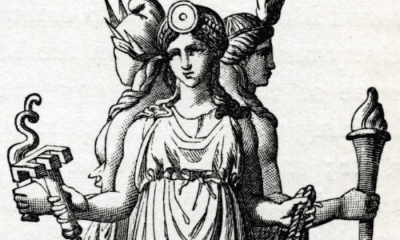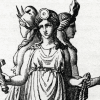Greek
What is Artemis’ Roman Name?
Most Greek gods have a Roman paralell, but in the case of Artemis and Diana there are both obvious similarities and striking distances in how they were worshipped.
It is well-known that Roman religion was heavily influenced by that of Greece. In most cases, both the gods and their legends seem to have been imported to Rome with few differences other than names and locations.
Most gods and goddesses, however, had existed in some form among the Italians before they were Hellenized. Occasionally, the legends and beliefs among the Romans showed glimpses of their pre-Greek origins.
Diana, the Roman Artemis, was one example of a goddess whose early origins were somewhat maintained in classical Roman mythology. While her stories and image were virtually identical to those of Artemis, a few differences between them give insight into the ancient Latin goddess who took on Greek attributes.
Diana in Rome
In Rome, the goddess of the hunt was known as Diana.
Early in their history, the people of Rome had adopted much of the mythology of their Italian neighbors. Many of the names of their gods and goddesses came from Etruscan.
The Etruscan gods seem to have been rather impersonal entities, though, without human forms or a complex, narrative-based mythology. For more relatable stories, the Romans looked to Greece.
The early Romans made an effort to model their culture after that of Greece. They claimed descent from Greek gods and heroes and considered themselves to be the successors to the great art, literature, and philosophy of the Peloponnesian.
Roman gods, therefore, became almost exact copies of their Greek counterparts. Most myths were almost entirely the same, with only the names changed to those of earlier Italian deities.
The name Diana stems from the Latin word dius, or “godly.” Like many Roman deities, it had been the name given to a goddess worshipped by natives of Italy before the influence of Greek mythology.
Diana was a goddess worshipped throughout Italy, not just by the early Romans. She may have been one of the earliest goddesses worshipped in Rome itself, as they claimed her first temple had been built by one of their earliest kings.
Both her widespread worship and her name suggest that she was a major figure in the Latin pantheon before its Hellenization. Diana was also written about as being a triple goddess or part of a triad, with different groups given, leading some historians to believe that her role was once much broader but had been split between several Greek-inspired deities.
The version of the goddess that the Romans adopted into their own pantheon originated near Lake Nemi, roughly 30 kilometers south of Rome itself. When the early Romans sought to unite the Latin tribes, in about the 6th century BC, they brought the goddess to Rome as a sign of that unity.
The Diana of Lake Nemi was a huntress as well, making her association with the Greek Artemis logical. Even before the Romans adopted the stories of her mythology, artists brought in from Greece to build temples made the connection between Artemis and Diana in their works.
Like many Roman gods, Diana did retain a few qualities that made her distinct from the Greek goddess that inspired her.
Hellenistic Greeks had already begun to envision Artemis as a goddess of all of the countryside, not just the wild mountains and forests. The Romans continued this with Diana, making her a goddess of farmlands and rural settlements as well as the forest.
Diana also adopted many of the roles that had been attributed to Hermes in Greek mythology. As a rural goddess, she watched over roads and travelers and became a goddess of travel.
This included travel between the worlds of the living and dead. The Romans thought of Diana as a psychopomp, or guardian of the dead, and often conflated her with the goddess of witchcraft, Hecate.
The Romans included birth as one of the travels Diana watched over. While the Greeks had shared this view with Artemis, the Romans viewed her as more of a fertility goddess although they generally considered her to be a sworn virgin.
My Modern Interpretation
While Diana’s name was adopted from an Italian culture, her origins may not have been at Lake Nemi. In fact, the association between Artemis and Diana may have been a circular one.
The people who lived in Italy before the rise of Roman power were not ignorant of their Greek neighbors. In many places, they had been in quite close contact with them for centuries.
Greece was a colonial power in the ancient Mediterranean. In addition to settling the many islands of the sea and cities all along the coast of Asia Minor, they also established colonies on mainland Italy.
The first of these Italian colonies, Cuma, was founded in the 8th century BC. They introduced many aspects of Greek culture to the area, including the alphabet that would eventually be used in Latin.
It is very likely that they introduced their gods as well.
According to legend, the sanctuary at Lake Nemi was founded by Orestes and Iphigenia. When Agamemnon tried to sacrifice his daughter, Iphigenia, Artemis spared the girl and replaced her with a deer at the last moment.
In the story told at Lake Nemi, which is not found in Greek records, Iphigenia was taken to a land ruled by people called the Tauri to find her brother, Orestes. The two fled to Italy where they established the temple of Artemis Taurolpolos to thank the goddess for saving her.
While the epithet Tauropolos may refer to this legendary city, it also contained the word for bull. This association with cattle by a goddess usually associated with wildlife suggests that some ancient version of Artemis/Diana was an agricultural goddess.
It was common for Roman legends to include the establishment of both locations and religious institutions by Greek figures, particularly those said to have left after the Trojan War. But the fact that this story was told at Lake Nemi more than in Rome itself suggests that the story of Greek influence may have been an early aspect of the cult there, perhaps before it was taken to the city.
The Latin tribes of the area were known to have contact with both Greek settlers and Phoenician traders long before Romen’s rise as a superpower. It is possible that their own local goddess of nature had already begun to take on attributes of Artemis because of this contact.
When Greek artists began constructing Diana’s temples, they may not have entirely imagined the similarities between the Italian goddess and their own. Rather than just sharing a common prehistoric root, it is possible that Diana’s attributes had already been influenced by Greek culture.
In Summary
The Roman version of Artemis was called Diana. Although her role int he pantheon was largely identical to that of her Greek counterpart, Diana had some unique attributes as well.
Diana was associated with the entirety of the countryside, rather than just the forest. While this belief had begun in some parts Hellenistic Greece, it was standard in Rome.
Diana was also associated with fertility to a greater extent than Artemis had been. While Artemis was a midwife goddess who watched over children and laboring women, her Roman counterpart’s role in procreation was more pronounced.
This is in part because Diana was also a nominal goddess who watched over crossroads and travellers. In Greek mythology this had most often been the task of Hermes.
Thus, Hecate was one of the goddesses said to be a close associate or another aspect of Diana. In fact, the Romans included her among many groupings of goddesses they considered to have related functions.
All of this suggests that the pre-Hellenized Diana may have been a more central figure in early Latin religion. Her worship was widespread, although the particular version adopted into Rome came from a nearby Latin tribe.
Like all Roman gods, Diana’s character and role changed as they were Hellenized. There is some evidence, however, that colonists and traders had already influenced the worship of Diana before the practice became common in the Roman kingdom.



